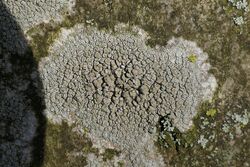Biology:Glaucomaria
| Glaucomaria | |
|---|---|

| |
| Glaucomaria carpinea | |
| Scientific classification | |
| Domain: | Eukaryota |
| Kingdom: | Fungi |
| Division: | Ascomycota |
| Class: | Lecanoromycetes |
| Order: | Lecanorales |
| Family: | Lecanoraceae |
| Genus: | Glaucomaria M.Choisy (1929) |
| Type species | |
| Glaucomaria rupicola (L.) P.F.Cannon (2022)
| |
| Species | |
|
G. bicincta | |
Glaucomaria is a genus of lichen-forming fungi in the family Lecanoraceae.[1] It has seven species. The genus was circumscribed by Maurice Choisy in 1929.[2] It contains crustose lichens formerly placed in the Lecanora rupicola species complex as defined by several previous authors.[3][4][5]
Description
Glaucomaria is characterised by a crust-like (crustose) thallus, which is sometimes spread out with a radiating pattern ([[Glossary of lichen terms#{{biology:{1}}}|{{Biology:{1}}}]]). The colour of the thallus ranges from white-yellowish green to pale grey. The apothecia (fruiting bodies) initially grow attached ([[Glossary of lichen terms#{{biology:{1}}}|{{Biology:{1}}}]]) and can become slightly raised ([[Glossary of lichen terms#{{biology:{1}}}|{{Biology:{1}}}]]) or nearly stalked (substipitate). These apothecia feature a heavily powdery ([[Glossary of lichen terms#{{biology:{1}}}|{{Biology:{1}}}]]) [[Glossary of lichen terms#{{biology:{1}}}|{{Biology:{1}}}]] that reacts to the C spot test to produce an intense lemon-yellow colour. The margin of the apothecia is persistent, sometimes being pushed aside (finally excluded), and occasionally surrounded by a black, wavy ([[Glossary of lichen terms#{{biology:{1}}}|{{Biology:{1}}}]]) ring.[6]
The outer layer of the apothecia ([[Glossary of lichen terms#{{biology:{1}}}|{{Biology:{1}}}]]) typically has a [[Glossary of lichen terms#{{biology:{1}}}|phenocorticate]] cortex (containing hyphal fragments and dead, collapsed algal cells), numerous algal cells, and both large and small crystals, with the latter dissolving in a solution of potassium hydroxide (K). The inner layer ([[Glossary of lichen terms#{{biology:{1}}}|{{Biology:{1}}}]]) ranges from thin to thick, dark on the outside and upper part but colourless inside. The [[Glossary of lichen terms#{{biology:{1}}}|{{Biology:{1}}}]] (topmost layer of the apothecia) is brown to dark brown with crystals, both the pigment and crystals dissolving in K. The hymenium, the spore-producing layer, is colourless and does not contain oil droplets. The paraphyses (sterile filaments in the hymenium) are slightly thickened at the top. The layer below the hymenium ([[Glossary of lichen terms#{{biology:{1}}}|{{Biology:{1}}}]]) is colourless and not interspersed with droplets.[6]
The asci (spore-bearing cells) of Glaucomaria are club-shaped ([[Glossary of lichen terms#{{biology:{1}}}|{{Biology:{1}}}]]) and very thin-walled. They contain a tall structure in the middle ([[Glossary of lichen terms#{{biology:{1}}}|{{Biology:{1}}}]]) that reacts to iodine and potassium hydroxide by turning blue (K/I+ blue), surrounded by a blue outer layer (Lecanora-type). The [[Glossary of lichen terms#{{biology:{1}}}|{{Biology:{1}}}]] are single-celled, hyaline (translucent), ellipsoid, and have a wall less than 1 µm thick. The [[Glossary of lichen terms#{{biology:{1}}}|{{Biology:{1}}}]], the photosynthetic partner of the lichen, is [[Glossary of lichen terms#{{biology:{1}}}|{{Biology:{1}}}]] a type of green algae (chlorococcoid).[6]
Chemistry
Glaucomaria contains a variety of compounds including arthothelin, atranorin, chloroatranorin, eugenitol, isoarthothelin, and methyl 3a-hydroxy-4-O-demethylbarbatate. Some species also have sordidone, psoromic acid, thiophanic acid, dichlorlichexanthone, and 2,5,7-trichlornorlichenxanthone. The pruina (powdery substance) on the apothecial disc contains sordidone and occasionally thiophanic acid.[6]
Species
- Glaucomaria bicincta (Ramond) S.Y.Kondr., Lőkös & Farkas (2019)
- Glaucomaria carpinea (L.) S.Y.Kondr., Lőkös & Farkas (2019)
- Glaucomaria leptyrodes (G.B.F.Nilsson) S.Y.Kondr., Lőkös & Farkas (2019)
- Glaucomaria lojkaeana (Szatala) S.Y.Kondr., Lőkös & Farkas (2019)
- Glaucomaria rupicola (L.) P.F.Cannon (2022)
- Glaucomaria subcarpinea (Szatala) S.Y.Kondr., Lőkös & Farkas (2019)
- Glaucomaria swartzii (Ach.) S.Y.Kondr., Lőkös & Farkas (2019)
References
- ↑ "Glaucomaria". Species 2000: Naturalis, Leiden, the Netherlands. https://www.catalogueoflife.org/data/taxon/62SG9.
- ↑ Choisy, M. (1929). "Genres nouveaux pour la lichénologie dans le groupe des Lecanoracées" (in fr). Bulletin de la Société Botanique de France 76 (3): 521–527. doi:10.1080/00378941.1929.10837179. Bibcode: 1929BSBF...76..521C.
- ↑ Grube, Martin; Baloch, Elisabeth; Arup, Ulf (2004). "A phylogenetic study of the Lecanora rupicola group (Lecanoraceae, Ascomycota)". Mycological Research 108 (5): 506–514. doi:10.1017/S0953756204009888. PMID 15230003. https://lup.lub.lu.se/record/137475.
- ↑ Blaha, J.; Grube, M. (2007). "The new species Lecanora bicinctoidea, its position and considerations about phenotypic evolution in the Lecanora rupicola group". Mycologia 99 (1): 50–58. doi:10.1080/15572536.2007.11832600. PMID 17663123.
- ↑ Zhao, X.; Leavitt, S.D.; Zhao, Z.T.; Zhang, L.L.; Arup, U.; Grube, M.; Pérez-Ortega, S.; Printzen, C. et al. (2015). "Towards a revised generic classification of lecanoroid lichens (Lecanoraceae, Ascomycota) based on molecular, morphological and chemical evidence". Fungal Diversity 78: 293–304. doi:10.1007/s13225-015-0354-5.
- ↑ 6.0 6.1 6.2 6.3 Nimis, P.L.; Martellos, S.. "Glaucomaria". https://italic.units.it/index.php?procedure=genuspage&ID_genus=481.
Wikidata ☰ Q75380499 entry
 |

